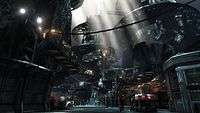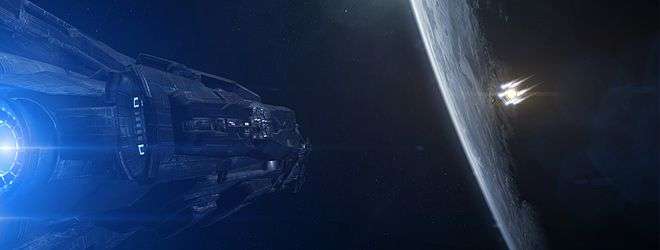Lost Planet 3 – Review
by Ian
|
 Gaming of late has become bogged down with emulating the ‘real’. From endless military shooters to gritty reboots of once-famous videogame icons, it is increasingly becoming an art form that imitates life. I often long for a seemingly-bygone era, yearning for a game that thrills me with exciting and outlandish scenarios, such as pitting giant mechs against imaginatively-horrific alien creatures in a variety of locales.
Gaming of late has become bogged down with emulating the ‘real’. From endless military shooters to gritty reboots of once-famous videogame icons, it is increasingly becoming an art form that imitates life. I often long for a seemingly-bygone era, yearning for a game that thrills me with exciting and outlandish scenarios, such as pitting giant mechs against imaginatively-horrific alien creatures in a variety of locales.
Try as it might, however, Lost Planet 3 is not the game my mis-spent youth desires.
Developed by Spark Unlimited (most famous for the middling Call of Duty: Finest Hour way back in 2004), Lost Planet 3 drops you in to the boots of Jim Peyton, full-time rig driver and part-time Nicolas Cage tribute act, several years before the events of the first two games. Jim has just arrived on E.D.N.III, an icy and hostile environment, to take on contract work for the Neo-Venus Construction Company (NEVEC for short) in order to provide a future for his wife and young son back on Earth. In theory, this means roaming the area around NEVEC’s base on the planet, the Coronis, patching up pipes, extracting thermal energy from wells and other odd jobs proposed to you by the base commander. In reality, as is so often the case on far-flung icy planets, things quickly start spiralling out of control.
Typical early missions are split between first-person movement in Jim’s rig (think a utilitarian Mr. Fixit bipedal mech) and more traditional third-person segments. When in the rig (sweetly named ‘Gertie’), you’ll alternate between walking around the planet, grabbing and drilling various contraptions, and fighting giant crab monsters – all in a day’s work for Nic Cage Jim. Once outside of the protective shell of Gertie, you’ll be running around the environment armed with a pistol and two main weapons, gunning down all kinds of Akrid – the aggressive indigenous life forms of E.D.N.III. – whilst working towards your given objective, be it collecting the reservoir of thermal energy from a well, or repairing a satellite uplink.
 Thermal energy is the entire reason for NEVEC being on the planet in the first place. A naturally-occurring phenomenon, it is seen to be the answer to the burgeoning energy crisis on Earth. It is found within the planet itself, and is also the blood of the Akrid that you constantly fight on excursions from the base. When killing Akrid, this thermal energy can be collected, which is handy because, as well as driving the plot along, it is used as the currency in Coronis. It is also awarded to you when completing missions, and can be used to purchase new weapons and rig upgrades. These options, however, appear to have little or no noticeable impact on the game, and the collection of thermal energy ended up seeming merely incidental rather than the driving force that it deserves to be.
Thermal energy is the entire reason for NEVEC being on the planet in the first place. A naturally-occurring phenomenon, it is seen to be the answer to the burgeoning energy crisis on Earth. It is found within the planet itself, and is also the blood of the Akrid that you constantly fight on excursions from the base. When killing Akrid, this thermal energy can be collected, which is handy because, as well as driving the plot along, it is used as the currency in Coronis. It is also awarded to you when completing missions, and can be used to purchase new weapons and rig upgrades. These options, however, appear to have little or no noticeable impact on the game, and the collection of thermal energy ended up seeming merely incidental rather than the driving force that it deserves to be.
Lost Planet 3 undeniably offers up a compelling premise, then: an alien environment, increasingly-huge Akrid enemies to fight, and mechs. Mechs! How can a game with mechs in it be bad? Well, unfortunately, by simply being Lost Planet 3. It somehow manages to take the thrill of piloting a gigantic robot into battle against alien monster crabs the size of a house, and turns it into a continuous trudge; never anything more than perfunctory. Jim’s rig is, in essence, a tool – and the game nails this feeling superbly.
 |
 |
 |
 |
 |
 |
The problem though, is that tools are boring. I want an awesome giant robot, not a glorified, if oversized, walking screwdriver. Even worse, movement when in the rig is slow, clunky and downright frustrating. Gertie feels about as responsive as an oil tanker, which leads to several discouraging moments when utilised in a fight; you know precisely what to do, but actually performing the action is hit and miss due to the amount of time the rig takes to respond to your commands.
 The on-foot gameplay fares little better. Combat has the weight and heft of Gears of War, but this is not a flattering comparison; the Akrid that you fight for the majority of the game are fast moving and difficult to hit at the best of times, let alone when fighting the slow and clunky controls. Jim doesn’t move quickly enough to avoid attacks, even when employing the dodge-roll move in a lot of cases. Happily, most Akrid go down with a shotgun blast or two, lessening the tedium to an extent.
The on-foot gameplay fares little better. Combat has the weight and heft of Gears of War, but this is not a flattering comparison; the Akrid that you fight for the majority of the game are fast moving and difficult to hit at the best of times, let alone when fighting the slow and clunky controls. Jim doesn’t move quickly enough to avoid attacks, even when employing the dodge-roll move in a lot of cases. Happily, most Akrid go down with a shotgun blast or two, lessening the tedium to an extent.
Aside from the garden-variety Akrid, there are ‘boss’ fights with larger specimens known as ‘Cat-L’ (large) or ‘Cat-G’ (giant). While impressively designed, these encounters are cliché to the point of absurdity. The Cat-L monsters boil down to giant crabs or scorpions, and the method of success is as old as the hills themselves – dodge the telegraphed attack, shoot the glowing weak spot, rinse, repeat….repeat….repeat. These larger enemies have absurd amounts of health for no apparent reason other than lengthening the ‘challenge’. All it actually does is extend the boredom.
Boredom sums up Lost Planet 3 pretty well. The gameplay mechanics are all completely functional, but there’s nothing exciting or fresh about them. Large parts of the game are spent jogging (slowly…oh so slowly) around the base, or trudging around the planet in your rig. It took me around ten hours to beat the main game without spending too much time on side missions, but it would be no exaggeration to say that at least half of this was time just spent walking around from one place to another. Although a quick-travel system is introduced, it is next to useless and merely replaces walking time with load screens; a poor compromise.
 Technically, the game is also fairly average. Graphics are nice enough, although quite grainy in a lot of places. Performance is hit and miss – frame rates take a noticeable drop in open areas to almost-unplayable levels, or when there is a lot of on-screen action, further exacerbating the sluggish controls when in a fight. At times, battles felt like they were being displayed as a slide-show, which often led to an unfair death.
Technically, the game is also fairly average. Graphics are nice enough, although quite grainy in a lot of places. Performance is hit and miss – frame rates take a noticeable drop in open areas to almost-unplayable levels, or when there is a lot of on-screen action, further exacerbating the sluggish controls when in a fight. At times, battles felt like they were being displayed as a slide-show, which often led to an unfair death.
It’s not all bad though. Lost Planet 3 does feature some interesting and compelling characters, and voice acting is very good throughout. In particular, the interplay between Jim and the base’s young engineer, Gale, often brought out a smile. Cut scenes are very well animated and serve to invest you in the character at an emotional level, especially when watching the messages being sent back and forth between Jim and his wife, Grace, back on Earth. With the exception of the eventual pantomime villain, all of the characters are well-rounded with many sides. In fact, the actions and revelations of some characters genuinely surprised me, especially considering the extremely dull and generic game that they’d been plonked in to. It became a case of tolerating the gameplay to learn more of the characters’ stories.
 |
 |
 |
 |
 |
 |
It’s hard to recommend Lost Planet 3, on balance. The game is dreadfully average in everything it does, despite a promising concept and engaging characters. Unfortunately, the overriding memory of this game for me is that I spent a lot of time bored…and even more time wishing I was playing something else instead.
Pros- Engaging characters
- Interesting enemy designs
- Decent story twists and turns
- Boring and generic gameplay
- Makes mechs dull
- Bland environments
Lost Planet 3 isn't a bad game as such...just a boring one. Interesting and well-developed characters aren't enough to save it from crushing boredom and uninteresting systems. The most damning thing of all is that it manages to make mechs boring; something that should be, frankly, nigh on impossible.
Last five articles by Ian
- Shooting Stars - Review
- Sora - Review
- Early Access - Epistory, Ironkraft, and Zombasite
- 1849 - Preview and Interview
- Diablo III: Reaper of Souls - Review

























There are no comments, yet.
Why don’t you be the first? Come on, you know you want to!